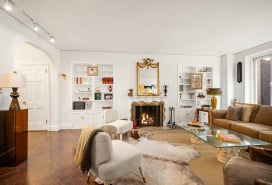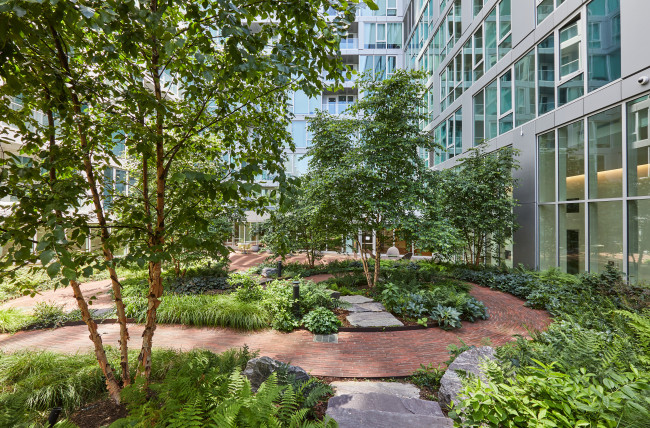Baby greens: How a mini green roof can spruce up the first floor of your building
- A handful of NYC condo buildings have gardens on the roof over their ground-floor commercial space
- Before jumping on the bandwagon, make sure your roof can hold the extra weight of large, potted plants

The mini green roof at the condo building at 345 West 14th St., dubbed 345meatpacking, even has trees.
Lauren Coleman for DDG/Azur
You’ve heard of green roofs—now get ready for the miniature version.
Many buildings have an extra strip of roof that juts out above a ground-floor commercial space. A handful of New York City condo developments are turning that otherwise unremarkable space into a small urban garden.
NYC has roughly 730 green roofs—large gardens, farms, or planted green spaces—but they can be difficult to spot from the city’s streets. These mini green roofs are closer to the street and more visible to pedestrians, who appreciate seeing more greenery, says Campbell Pool, the owner of Campbell’s Gardens, which designs and installs urban landscaping.
“People love it,” says Campbell, who installed the garden on top of the first-floor roof at 500 West 22nd St. “When we were doing maintenance or when we were doing the installation [on 22nd Street], people from the neighborhood would thank us. And I thought that was kind of beautiful.”
Seeing the green light
Developers have been adding greenery on top of a building’s ground-floor commercial space since at least 2014, when DDG wrapped up construction on its condo building and tree-lined roof at 345 West 14th Street, dubbed 345meatpacking. You can also spot the feature at the 13-story building at 55 West 17th in the Flatiron District.
But miniature green roofs have become particularly popular since the 2020 pandemic, says Joe McMillan, chairman and CEO of DDG.
“What the pandemic did in a lot of cases is not just increase the appreciation of your architecture, greenery, space, et cetera, but it also accelerated a lot of trends,” McMillan says. “I think that residents really appreciate green space.”

Greening the built environment
Both locals and residents get to enjoy the additional greenery, says Leonard Steinberg, chief evangelist at Compass. He is marketing 500 West 22nd St., also known as Park House.
The gardens help to absorb excess rainwater—something the city will see more of thanks to climate change. The roofs jut out over the sidewalk, sheltering passersby and sprucing up the block. Plus, it makes that second floor apartment look a lot more appealing, Steinberg adds.
“This canopy acts not only as a privacy screen, but it also acts as this beautiful garden,” Steinberg says. “It's really a win-win for those who don’t live in the building, those who live in the building, and anyone passing by the building. It's appealing. It's attractive.”
Originally Selldorf Architects founder Annabelle Selldorf, who designed the building, planned to use the greenery to separate the retail space from the residences, but says she soon realized it provided an additional benefit to the condo owners.
“We have designed many green roofs before Park House, but this is the first time we designed greenery to grow on top of an overhang canopy,” Selldorf says. “It quickly became clear that it was really an added amenity space where the residents of that floor are able to use it as their own private viewing garden.”

How to get your own mini green roof
If you want to pitch your property manager, condo or co-op board on going green, there’s a handful of steps to consider.
First of all, your board or landlord will need to make sure your building’s roof can support the weight of the plants and soil, particularly after a heavy rainfall. (If your roof isn’t strong enough, there are a handful of other ways to exercise your green thumb, like by installing planters or planting in tree beds—just be sure to use small plants that won't harm tree roots.)
You’ll also need to examine how much light your building gets to determine what plants are the best fit. For example, the overhang at 500 West 22nd St. goes around the corner of the property, which forced Campbell to select different plants for the sunny and shady side.
Any garden requires some maintenance, and it’s up to your board or landlord to determine how much work is worth the effort. Campbell recommends staying away from plants that have a short lifespan, and says he plans to visit the garden on 22nd Street about four times per year.
“We tried to use a lot of low maintenance-type plantings—things that didn't need a lot of trimming—while still making it look like a real garden,” Campbell says.































